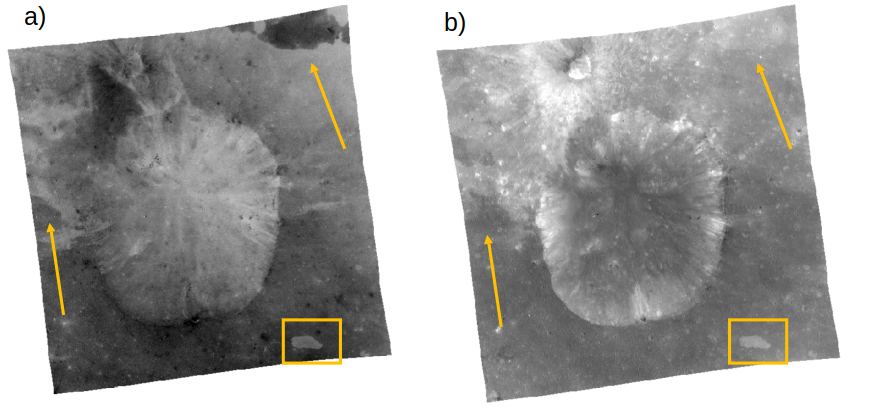Non-homogeneous population of orange material patches on Vesta
- 1Department of Astronomy and Space Informatics, V.N. Karazin Kharkiv National University, Ukraine
- 2Institute of Astronomy, V.N. Karazin Kharkiv National University. Kharkiv, Ukraine
Introduction
Asteroid (4) Vesta is a unique object among small solar system bodies: the second largest body in the main belt, a probable remnant protoplanet from the earliest epoch of the solar system formation [3], parent body of the large asteroid family and main reservoir of HED-material. Global albedo mosaic obtained by Dawn’s Framing Camera confirmed ground-based obvservation facts about heterogenity of vestan surface material. Among all areas with unusual spectral behavior stands out a pattern which was previously described in [2] and [1] as an orange material due to conformity of this deposits to the orange tones on the global false-color Clementine mosaics. Analysis provided in previous studies forced the authors ([2], [1]) to assume a connection of patches with the melts ejected during the formation of Rheasilvia. In this work, a detailed analysis of the all orange material areas (except regions near Claudia and Rubria craters) found in the ([2], [1]) was carried out using color-ratio imagery as applied to data obtained by Dawn spacecraft onboard instrument Framing Camera (FC).
Methods
We use color-ratio imagery method to analyze images obtained by Dawn spacecraft onboard instrument Framing Camera (FC) during HAMO orbital phase (spatial resolution ~70 m/pixel) in all color filters (F2-F8). For deriving color ratio maps in this study, we used Level 1b calibrated images available in free access as a part of Planetary Data System archive (https://sbn.psi.edu/pds/sbib/). We selected images of areas that demonstrate presence of orange material patches according to LeCorre et al. (2013). As the refferent color-ratio maps we used C(438nm/917nm) for spectral slope characterization and C(749nm/917nm) for estimation of the pyroxene band depth. Remaining color-ratio maps give an additional information which helps to interpretate spectral behavior of selected areas more accurate.
Results
Almost all spots within studied areas demonstrate similar spectral behavior. The pacthes of the orange material tend to have stronger absorption at 438 nm. Outside this area, the orange patches are practically indistinguishable from the typical vestan surface material. Patches also have deeper pyroxene band at 0.9 nm and higher albedo than surroundings. In fact, color ratio C(438nm/749nm) distribution maps demonstrate that the population of orange material spots is diverse in terms of shapes and sizes as well as sharpness of spots’ edges (Fig.1). Additionally, several spots, previously classified as orange material [2], show quite distinct spectral characteristics to traditional. Our results seem to contradict with impact melt hypothesis of orange material origin.

Fig. 1 – Oppia crater (8° S, 309° E, D=37km) and surroundings. Color ratio C(438nm/749nm) (a) and C(749nm/917nm) (b) maps.
References
[1] Garry, W. B., Williams, D. A., Aileen Yingst, R. et al., 2014. Icarus 244, 104–119
[2] Le Corre L., Reddy V., Schmedemann N. et al. 2013. Icarus 226, 1568–1594
[3] Russell C. T. and Raymond C. A. 2011. Space Sci. Rev. 163, 3-23
How to cite: Rychahova, V., Slyusarev, I., Kaydash, V., and Belskaya, I.: Non-homogeneous population of orange material patches on Vesta, Europlanet Science Congress 2024, Berlin, Germany, 8–13 Sep 2024, EPSC2024-577, https://doi.org/10.5194/epsc2024-577, 2024.